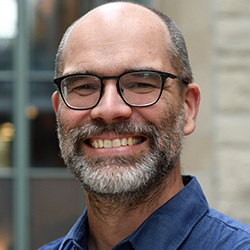Harnessing Environmental Science Sensor Data with a 5G Network
ECE undergraduate students help determine how to transfer scientific data to edge computing servers via a 5G network
Data-driven smart technologies are ubiquitous in homes and commercial buildings. Urban planners have also adopted these sensor devices for city-scale environmental monitoring, traffic management, and public health.
Ziad Elbadry Shaker, a second-year student in computer engineering, and Zoe Snead, a fourth-year student in electrical engineering, spent two months at the US Department of Energy’s Argonne National Laboratory researching the 5G transfer of sensor data as part of the Northwestern Argonne Institute of Science and Engineering (NAISE) summer undergraduate research program.
Launched in 2015, the Waggle project — led by Pete Beckman, NAISE codirector and Argonne distinguished fellow, and Rajesh Sankaran, Argonne experimental systems specialist and NAISE member — is a wireless sensor platform that can monitor environmental factors such as water quality, air pollutants, temperature, humidity, sound levels, and ambient light.
Argonne’s project – named in honor of the “waggle dance” honeybees use to signal the direction and distance of pollen sources – has been implemented in a range of studies, including examining live weather data to improve urban climate and weather models; evaluating congestion, energy, and emissions issues related to the expansion of O’Hare International Airport; gaining insights into water kinetics for flood mitigation efforts; and collecting data on travel habits, traffic patterns, and road conditions to guide decision making related to infrastructure projects and operations improvements.
“The system collects the data and runs AI algorithms to detect patterns,” Shaker said. “Waggle helps researchers better understand urban systems and make better decisions about developing smart cities.”
Shaker and Snead worked closely with Argonne researchers and Randall Berry, John A. Dever Chair of Electrical and Computer Engineering at Northwestern Engineering and NAISE member. During weekly meetings, Shaker and Snead shared their progress, discussed ideas, and received project guidance.
 “The strong connections between Northwestern and Argonne via NAISE provide excellent opportunities for ECE undergraduates to get hands on experience with cutting edge technologies like 5G wireless,” Berry said.
“The strong connections between Northwestern and Argonne via NAISE provide excellent opportunities for ECE undergraduates to get hands on experience with cutting edge technologies like 5G wireless,” Berry said.
Shaker’s project goal was to determine how to best maximize the transfer of the massive amount of scientific data collected and transmitted by the Waggle sensors to edge computing servers via a 5G network.
Shaker explained that edge computing is more efficient, allowing investigators to run more complex algorithms and programs. He was tasked with setting up a prototype edge computing server and helping establish the 5G connection between the servers and a small farm of Waggle sensors on site at Argonne. Once tested, the 5G system could then be rolled out to other Waggle sites, such as the Array of Things (AoT), an urban sensing project.
Although Shaker succeeded in setting up the server with the necessary resources to receive the Waggle data and start running the algorithms, the 5G network malfunctioned after a change in the setup of the radio towers.
“We were expecting to start running experiments by the end of the summer, but the 5G towers were not working correctly,” Shaker said. “We were not able to see the actual transfer of the data, but we were able to maintain a connection by transferring simple data.”
Shaker quickly shifted gears, curious about whether 5G could be created as an open-source network to lower the barriers of entry and encourage innovation. Shaker and Snead conducted research on the potential for an open source 5G core.
“When the towers malfunctioned, it sparked something in my mind,” Shaker said. “New technologies should be accessible for everyone.”
The project aligned with Shaker’s interests in applying his knowledge in service of computing for social good.
“Broadly speaking, I'm interested in the usage of new technologies to solve the global issues we are facing and make the world a better place,” Shaker said. “For instance, how do we manage and use artificial intelligence, machine learning, and 5G to positively impact our world?"
The NAISE summer project was Shaker’s first experience conducting research on a scientific topic that relates to his field of study. The project also piqued Shaker’s interest in data science, leading him to join Northwestern Engineering’s Data Science and Engineering Minor, a program offered jointly by the Department of Industrial Engineering and Management Sciences and the Department of Computer Science.
“I would definitely love to do more research,” Shaker said. “It helps you to go through challenges that no one has tackled before.”
